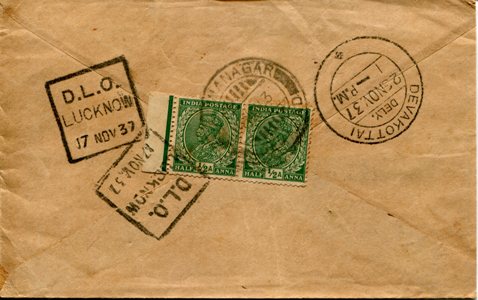D.L.O. System

Preamble
The aim of this brief account of Postal Receipts, Acknowledgements and Lables is to enable collectors to understand and identify such of them as pass through the Post and become the property of receivers or are given to the customers as a part of postal transactions. I have selected only the commonly seen from and wherever possible given the departmental numbers assigned to them, which are sometimes printed on them.
An Introduction
The Post office rules 25-27 of 1837 first brought out the concept of Dead Letter in India.
It prescribed the treatment of undeleivered letters lying at any post office for longer than three months.
Initially these were sent to the GPO of the Presidency ;
and lists of such undeleivered letters and parcels were published in the official Gazette.
They remained at the GPO for 18 months and, after a further period of 12 months, they were destroyed.
The Dead Letter Offices were established somewhere in 1860s but it was only towards the end of the decade that actual markings were used on envelops and other postal material.
DLO (Dead Letter Office) after 1980 was known as RLO Returned Letter Office.
D.L.O. Labels
At least from 1881, the D.L.Os were using three printed labels for affixing undelivered articles passed to them for tracing and disposal. These were “Unclaimed Letter-Free”, “Refused Letter” and “Redirected Letter” labels. In 1903, the first two were amalgamated as an “Unclaimed/Refused Letters” label.
From Numbers : (a) “Unclaimed Letter-Free”
By 1881, No. 122; By 1889, D.L.O. 10; 1903,
abolished.
(b) “Refused Letter”
By 1881, No. 123; By 1889, D.L.O. 11; 1903,
abolished.
(c) “Redirected Letter”
By 1881, No. 124; By 1889, D.L.O. 12; 1903,
D.L.O. 12 (revised - with printed name of Office);
1910, D.L.O. 12 (further revised-without printed
name but with a box for the Name Stamp).
(d) “Unclaimed Letter”
Refused
1903, D.L.O. 10 (with printed name of office);
1910, D.L.O. 10 (revised without printed name
but with a afox for the name Stamp).
Stamp Label for an Unregistered Parcel/Label for Postage Stamps
This label was introduced in 1885. Postage stamps were affixed on it and then it was pasted on a parcel to safeguard against the stamps falling off from the cover of the Parcel. It was found to be so useful that by 1897 it was permitted to be used on all postal
articles and was renamed “Label for Postage Stamps”.
From Numbers : 1895,P-23; 1897, P-23 (revised).
Empty Cover Label
Introduced in 1907. Affixed to covers received open without contents. Invited addressess to furnish information for tracing missing contents.
Form Numbers : 1907, Del. -2
“Refused Letter” Label
Introduced in 1913 for use by Head Offices so as to avoid such covers being sent to a D.L.O., if the sender’s address was available on the cover.
Form Number : 1913, Dep.-7.
top
|

